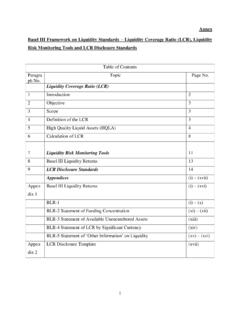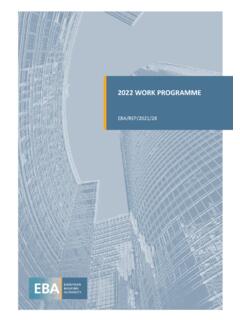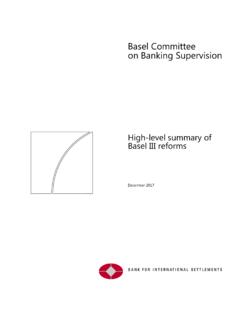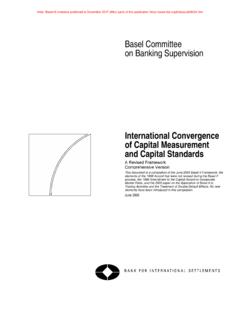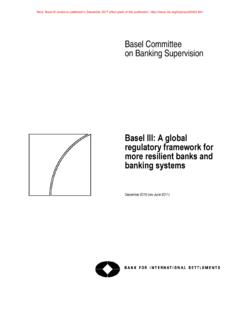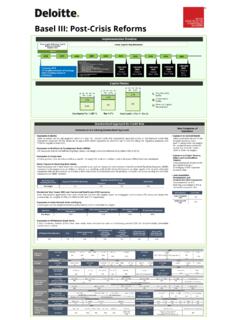Transcription of Minimum Capital Requirements
1 12 Part 2: The First Pillar Minimum Capital Requirements I. Calculation of Minimum Capital Requirements 40. Part 2 presents the calculation of the total Minimum Capital Requirements for credit, market and operational risk. The Capital ratio is calculated using the definition of regulatory Capital and risk-weighted assets. The total Capital ratio must be no lower than 8%. Tier 2 Capital is limited to 100% of Tier 1 Capital . A. Regulatory Capital 41. The definition of eligible regulatory Capital , as outlined in the 1988 Accord and clarified in the 27 October 1998 press release on Instruments eligible for inclusion in Tier 1 Capital , remains in place except for the modifications in paragraphs 37 to 39 and 43.
2 The definition is outlined in paragraphs 49 (i) to 49 (xviii) and in Annex Ia. 42. Under the standardised approach to credit risk, general provisions, as explained in paragraphs 381 to 383, can be included in Tier 2 Capital subject to the limit of of risk-weighted assets. 43. Under the internal ratings-based (IRB) approach, the treatment of the 1988 Accord to include general provisions (or general loan-loss reserves) in Tier 2 Capital is withdrawn. Banks using the IRB approach for securitisation exposures or the PD/LGD approach for equity exposures must first deduct the EL amounts subject to the corresponding conditions in paragraphs 563 and 386, respectively.
3 Banks using the IRB approach for other asset classes must compare (i) the amount of total eligible provisions, as defined in paragraph 380, with (ii) the total expected losses amount as calculated within the IRB approach and defined in paragraph 375. Where the total expected loss amount exceeds total eligible provisions, banks must deduct the difference. Deduction must be on the basis of 50% from Tier 1 and 50% from Tier 2. Where the total expected loss amount is less than total eligible provisions, as explained in paragraphs 380 to 383, banks may recognise the difference in Tier 2 Capital up to a maximum of of credit risk-weighted assets.
4 At national discretion, a limit lower than may be applied. B. Risk-weighted assets 44. Total risk-weighted assets are determined by multiplying the Capital Requirements for market risk and operational risk by ( the reciprocal of the Minimum Capital ratio of 8%) and adding the resulting figures to the sum of risk-weighted assets for credit risk. The Committee applies a scaling factor in order to broadly maintain the aggregate level of Minimum Capital Requirements , while also providing incentives to adopt the more advanced risk-sensitive approaches of the The scaling factor is applied to the risk-weighted asset amounts for credit risk assessed under the IRB approach.
5 11 The current best estimate of the scaling factor is National authorities will continue to monitor Capital Requirements during the implementation period of this framework . Moreover, the Committee will monitor national experiences with this framework . 13 C. Transitional arrangements 45. For banks using the IRB approach for credit risk or the Advanced Measurement Approaches (AMA) for operational risk, there will be a Capital floor following implementation of this framework . Banks must calculate the difference between (i) the floor as defined in paragraph 46 and (ii) the amount as calculated according to paragraph 47.
6 If the floor amount is larger, banks are required to add times the difference to risk-weighted assets. 46. The Capital floor is based on application of the 1988 Accord. It is derived by applying an adjustment factor to the following amount: (i) 8% of the risk-weighted assets, (ii) plus Tier 1 and Tier 2 deductions, and (iii) less the amount of general provisions that may be recognised in Tier 2. The adjustment factor for banks using the foundation IRB approach for the year beginning year-end 2006 is 95%. The adjustment factor for banks using (i) either the foundation and/or advanced IRB approaches, and/or (ii) the AMA for the year beginning year-end 2007 is 90%, and for the year beginning year-end 2008 is 80%.
7 The following table illustrates the application of the adjustment factors. Additional transitional arrangements including parallel calculation are set out in paragraphs 263 to 269. From year-end 2005 From year-end 2006 From year-end 2007 From year-end 2008 Foundation IRB approach12 Parallel calculation 95% 90% 80% Advanced approaches for credit and/or operational risk Parallel calculation or impact studies Parallel calculation 90% 80% 47. In the years in which the floor applies, banks must also calculate (i) 8% of total risk-weighted assets as calculated under this framework , (ii) less the difference between total provisions and expected loss amount as described in Section (see paragraphs 374 to 386), and (iii) plus other Tier 1 and Tier 2 deductions.
8 Where a bank uses the standardised approach to credit risk for any portion of its exposures, it also needs to exclude general provisions that may be recognised in Tier 2 for that portion from the amount calculated according to the first sentence of this paragraph. 48. Should problems emerge during this period, the Committee will seek to take appropriate measures to address them, and, in particular, will be prepared to keep the floors in place beyond 2009 if necessary. 49. The Committee believes it is appropriate for supervisors to apply prudential floors to banks that adopt the IRB approach for credit risk and/or the AMA for operational risk following year-end 2008.
9 For banks that do not complete the transition to these approaches in the years specified in paragraph 46, the Committee believes it is appropriate for supervisors to continue to apply prudential floors similar to those of paragraph 46 to provide time to ensure that individual bank implementations of the advanced approaches are sound. However, the Committee recognises that floors based on the 1988 Accord will become increasingly impractical to implement over time and therefore believes that supervisors should have the flexibility to develop appropriate bank-by-bank floors that are 12 The foundation IRB approach includes the IRB approach to retail.
10 14 consistent with the principles outlined in this paragraph, subject to full disclosure of the nature of the floors adopted. Such floors may be based on the approach the bank was using before adoption of the IRB approach and/or AMA. Ia. The constituents of Capital A. Core Capital (basic equity or Tier 1) 49(i). The Committee considers that the key element of Capital on which the main emphasis should be placed is equity capital13 and disclosed reserves. This key element of Capital is the only element common to all countries' banking systems; it is wholly visible in the published accounts and is the basis on which most market judgements of Capital adequacy are made; and it has a crucial bearing on profit margins and a bank's ability to compete.










